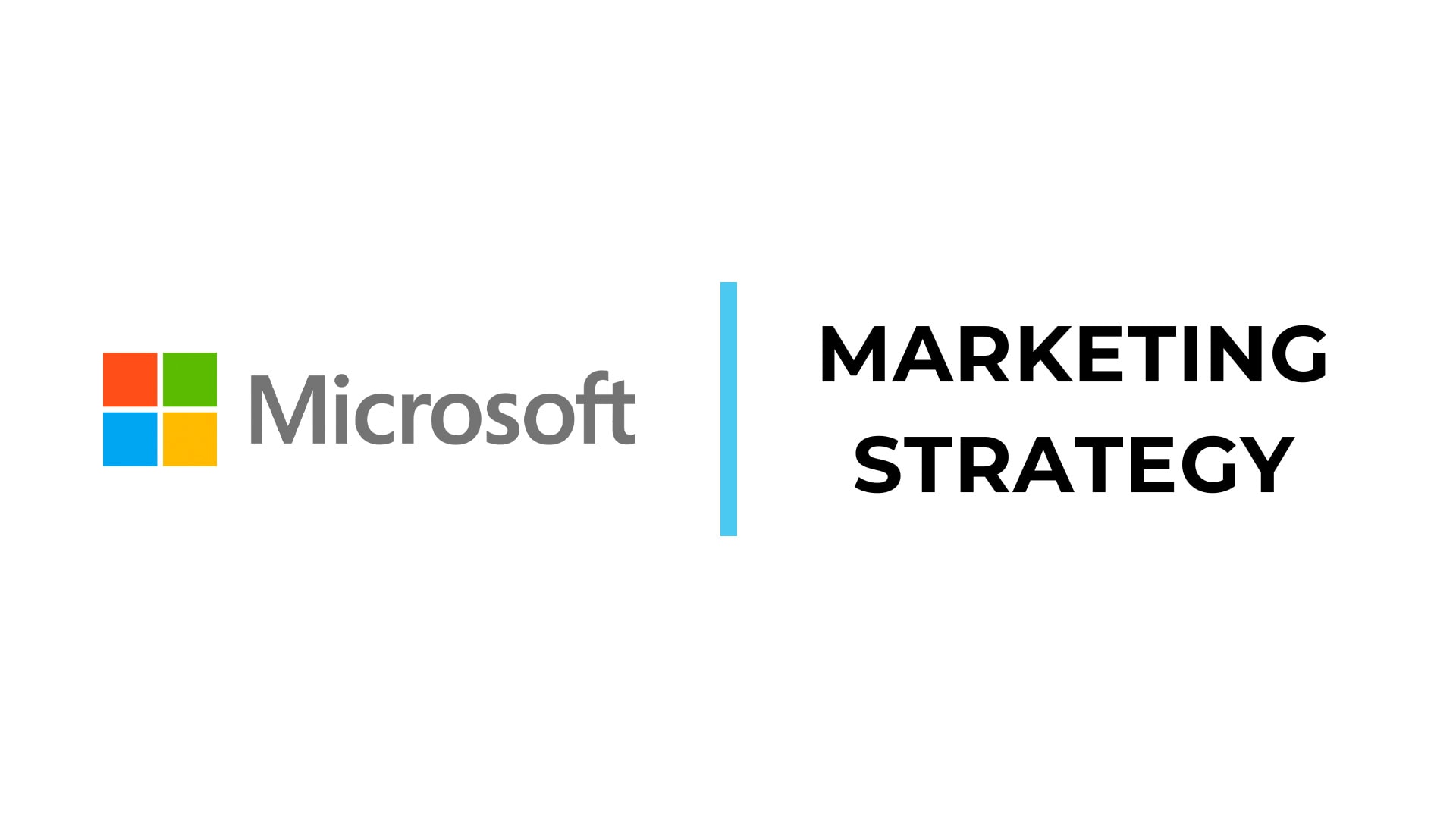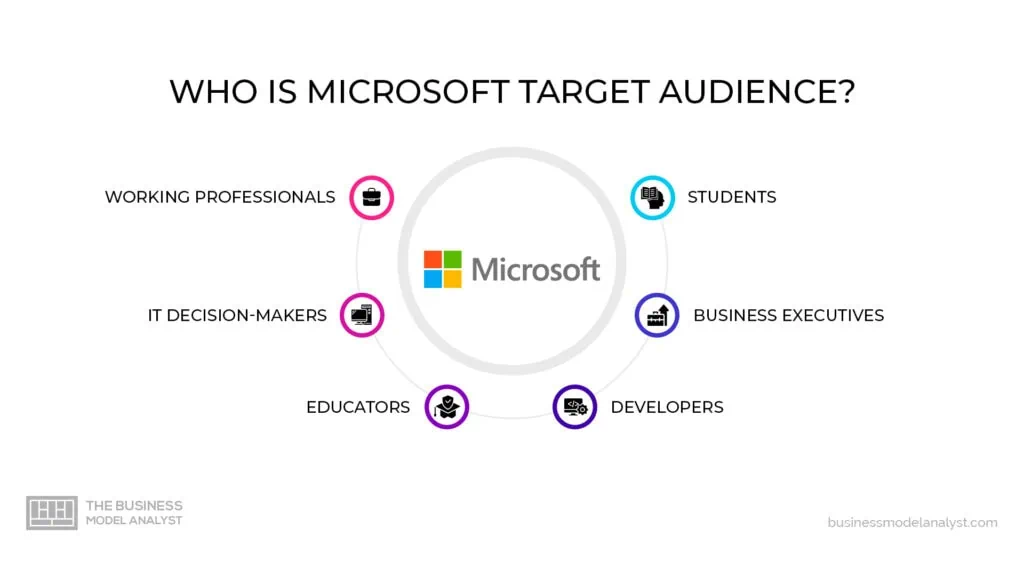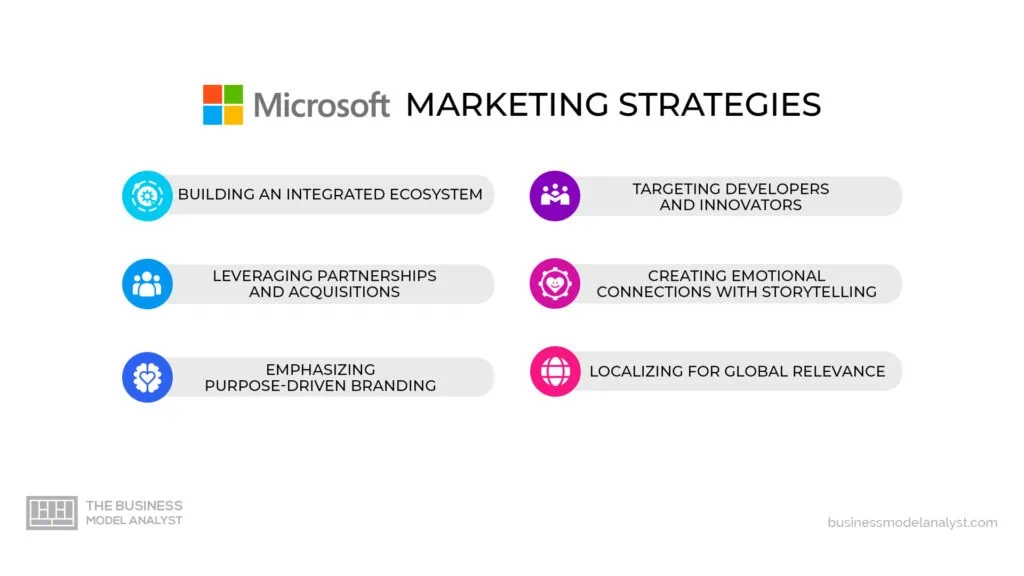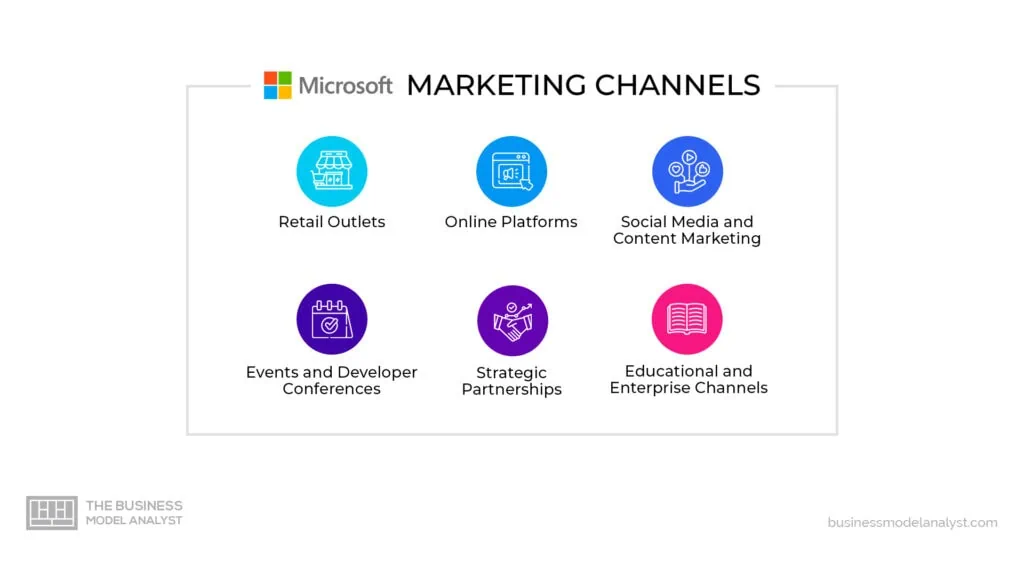Microsoft Marketing Strategy (2025)

The Microsoft Marketing Strategy combines product innovation, strategic partnerships, and customer-centric campaigns to dominate the global tech landscape. This approach ensures Microsoft’s continued relevance across business, educational, and consumer markets. By aligning its messaging with modern digital needs, Microsoft business model has built a brand that is both powerful and personal.
Founded in 1975, Microsoft started with a vision to place a computer on every desk and in every home. Today, it stands as a tech titan, shaping everything from enterprise software to gaming and cloud computing. Through products like Windows, Office, Azure, and Xbox, Microsoft influences the daily digital lives of billions. Its evolution from a software-centric company to a cloud-first, AI-powered platform reflects its adaptability and foresight.
What distinguishes Microsoft is its balance of scale and personalization. While it operates globally, it maintains relevance locally—offering tools tailored to regional markets and sectors. Unlike competitors who often focus solely on innovation or ecosystem lock-in, Microsoft business model emphasizes and integration, accessibility, and value creation.
This strategy mirrors broader consumer shifts: the need for seamless digital experiences, trust in data security, and demand for hybrid work solutions. Whether empowering students through educational tools or enabling enterprises with advanced cloud services, Microsoft business model isn’t just selling software—it’s enabling possibility. Its marketing reinforces this mission, turning complex technologies into compelling, user-friendly solutions.
Microsoft Goals and Objectives
Microsoft’s marketing goals center on empowering every person and organization on the planet to achieve more. Its objectives aim to drive innovation, expand reach, and deepen engagement through platforms that serve both consumer and enterprise needs. These goals reflect Microsoft’s commitment to global impact, customer-centric growth, and technological leadership.
Expand Cloud Adoption through Azure
Azure is Microsoft’s flagship cloud platform, and expanding its user base is a top priority. Through industry-specific solutions, global data centers, and robust security features, Microsoft aims to convert traditional IT users into cloud-native customers, especially in healthcare, finance, and government.
Increase Brand Loyalty Across Ecosystems
From Xbox gamers to Office 365 subscribers, Microsoft fosters long-term relationships through seamless integration across its products. Loyalty programs, user communities, and bundled services—like Microsoft 365 Family—keep customers engaged and invested in the Microsoft ecosystem.
Penetrate Emerging Markets
Microsoft actively develops solutions for price-sensitive regions. By offering localized versions of Office, affordable Surface devices, and educational partnerships, it expands digital access in Asia, Africa, and Latin America, driving market share in underserved areas.
Drive Enterprise Transformation with AI and Data
Microsoft markets its AI-powered tools, like Copilot in Office and Dynamics 365, to help businesses make data-driven decisions. By showcasing real-world use cases, like automated customer service or predictive maintenance, it positions itself as essential for digital transformation.
Engage Developers through Ecosystem Support
Through initiatives like GitHub, Visual Studio, and Microsoft Learn, the company nurtures a global developer community. These users not only build on Microsoft platforms but also advocate for its tools, creating organic growth and sustained engagement.
Champion Sustainability and Trust
Microsoft’s marketing highlights its carbon-negative goals and ethical AI principles. These values resonate with modern consumers and B2B clients, especially those seeking purpose-driven partnerships.
Each objective not only supports Microsoft’s bottom line but also reinforces its mission to be inclusive, intelligent, and innovative in an ever-evolving tech world.
Who is Microsoft’s Target Audience?


Microsoft’s marketing strategy serves a diverse yet precisely segmented audience. It caters to individuals, enterprises, governments, and educational institutions—each with unique needs. By understanding demographic, psychographic, geographic, and behavioral traits, Microsoft delivers tailored solutions that create value and long-term loyalty.
Microsoft Demographics
Microsoft targets multiple age groups: from students using Office 365 to retirees managing finances with Excel. Its core demographics include working professionals (25–54), IT decision-makers, educators, developers, and business executives. Income levels range from middle-class consumers to high-net-worth enterprise clients. Gender-neutral and inclusive, Microsoft designs its products for broad accessibility and adoption.
Microsoft Psychographics
Microsoft appeals to purpose-driven users who prioritize productivity, innovation, and collaboration. Its products serve both tech enthusiasts and pragmatic users who value ease of use. Whether you’re a gamer seeking immersive experiences or a business owner aiming for efficiency, Microsoft’s messaging emphasizes empowerment, reliability, and continuous learning.
Microsoft Geography
As a global brand, Microsoft reaches audiences in over 190 countries. Its strongest markets include the U.S., Europe, India, and China, but it’s also expanding aggressively in Africa and Latin America. Microsoft localizes products through language support, region-specific pricing, and market-relevant solutions—like Indian language packs or African education initiatives.
Microsoft Behavior
Users interact with Microsoft in various ways—subscribing to Office 365, purchasing Surface devices, or using Azure for cloud development. Many exhibit high brand loyalty, especially enterprise customers who rely on Microsoft ecosystems for daily operations. Behavioral traits include frequent updates, cross-platform usage, and preference for integrated experiences across work, play, and learning.
Microsoft successfully tailors offerings to each audience segment—students get free Office access, developers find open-source tools on GitHub, and enterprises receive AI-enhanced cloud infrastructure. By deeply understanding its audience, Microsoft ensures its marketing is both strategic and human-centered.
Marketing Mix of Microsoft
Microsoft’s marketing mix strategically combines its product variety, pricing models, global availability, and promotional strength to maintain dominance in the tech industry. Each element of the 4Ps reinforces Microsoft’s mission to empower users and organizations through technology.
Microsoft Product
Microsoft’s core offerings include software like Windows, Office 365, and Microsoft Teams, as well as hardware such as Surface devices and Xbox consoles. Its cloud platform, Azure, supports businesses worldwide. Microsoft also leads in AI integration, embedding Copilot into Office apps. This extensive portfolio ensures relevance across education, gaming, productivity, and enterprise sectors.
Microsoft Price
Microsoft uses value-based and tiered pricing. Office 365, for instance, is available in personal, family, and business plans to suit different budgets. Azure follows a pay-as-you-go model, appealing to startups and enterprises alike. Educational discounts and free student licenses widen access. Its strategy balances affordability with premium offerings to maximize reach and revenue.
Microsoft Place
Microsoft distributes its products through physical retail stores, online platforms, authorized resellers, and global partners. It also leverages cloud-based delivery for software and services. Azure’s presence in multiple data regions enhances local accessibility and compliance. Xbox and Surface products are sold worldwide through both Microsoft’s own site and retail chains like Best Buy or Amazon.
Microsoft Promotion
Microsoft promotes through integrated marketing—advertising, influencer partnerships, content marketing, and community engagement. Campaigns like “Empowering Us All” spotlight real-world impact. Developer events like Microsoft Build and educational webinars further engagement. Social media, blogs, and YouTube extend reach, while traditional advertising still plays a role in enterprise outreach and product launches.
By aligning innovative products, competitive pricing, expansive distribution, and compelling promotions, Microsoft ensures sustained market leadership and consumer relevance across generations.
What are Microsoft’s Strategies?


Microsoft’s marketing strategies focus on long-term engagement, innovation leadership, and purpose-driven branding. Through a combination of technological excellence and human-centered narratives, the company continually strengthens its market position and customer trust.
Building an Integrated Ecosystem
Microsoft connects products like Windows, Office, Azure, and Teams into a seamless ecosystem. This integration simplifies user experiences and encourages product stickiness. A business using Microsoft 365 is more likely to adopt Azure, Teams, and Power BI—creating a self-reinforcing cycle of utility and loyalty.
Leveraging Partnerships and Acquisitions
Strategic acquisitions such as LinkedIn, GitHub, and Activision Blizzard allow Microsoft to expand into social, developer, and gaming sectors. These platforms become both product extensions and marketing channels. Partnerships with companies like SAP and Adobe enhance Microsoft’s enterprise credibility and cross-platform synergy.
Emphasizing Purpose-Driven Branding
Microsoft highlights social responsibility in campaigns, promoting sustainability goals and ethical AI development. Initiatives like carbon-negative commitments and accessibility-first design resonate with modern consumers and B2B clients. This positions Microsoft as not just a tech company, but a socially conscious brand.
Targeting Developers and Innovators
Through Visual Studio, GitHub, and Azure Dev Tools, Microsoft actively courts developers—the influencers of digital transformation. Events like Microsoft Build foster innovation while promoting tools that become industry standards. These efforts amplify organic growth and community-led advocacy.
Creating Emotional Connections with Storytelling
Microsoft uses emotionally resonant storytelling in campaigns—featuring real users overcoming challenges with its technology. Ads often spotlight students, professionals, and non-profits, tying tech to human empowerment. This approach bridges the gap between functionality and personal relevance.
Localizing for Global Relevance
Microsoft adapts its marketing to regional needs, offering culturally tailored messaging, language support, and localized pricing. From AI-powered language tools in India to education-focused programs in Kenya, localization ensures Microsoft resonates with a global audience while maintaining brand consistency.
By executing these strategies cohesively, Microsoft remains future-ready, inclusive, and deeply embedded in users’ personal and professional lives.
Microsoft Channels


Microsoft utilizes a diverse range of distribution channels to reach its vast audience—ensuring its products and messages are accessible, engaging, and tailored to various user needs. From digital platforms to physical touchpoints, each channel enhances brand visibility, customer interaction, and sales.
Retail Outlets
Microsoft sells products through its own branded stores (in select markets), partner retail chains like Best Buy, and pop-up locations for device demos and launches. These physical outlets offer hands-on experiences with products like Surface and Xbox, enhancing consumer confidence and driving in-person sales.
Online Platforms
Microsoft’s primary digital channel is its official website, which supports global purchases, downloads, subscriptions, and customer service. The Microsoft Store app allows users to purchase software, games, and services across devices. Additionally, platforms like Xbox Marketplace and Azure’s cloud portal cater to gamers and developers respectively.
Social Media and Content Marketing
Microsoft engages audiences through platforms like LinkedIn, X, Instagram, and YouTube. LinkedIn, in particular, is pivotal for B2B marketing, while YouTube hosts tutorials, keynote streams, and emotional storytelling campaigns. These channels reinforce brand values and educate users, driving product usage and loyalty.
Events and Developer Conferences
Live and virtual events like Microsoft Build and Ignite serve as high-impact channels to launch innovations, connect with developers, and share product roadmaps. These forums double as learning hubs and promotional tools, generating buzz within professional communities.
Strategic Partnerships
Microsoft reaches broader audiences by bundling its products with OEM partners (e.g., Dell, HP), mobile carriers, and service providers. These collaborations ensure pre-installed software, discounted packages, or subscription trials—helping capture new users at the point of hardware or service purchase.
Educational and Enterprise Channels
Through campus programs, educator training, and licensing deals with schools and corporations, Microsoft embeds its tools in institutional ecosystems. Microsoft Learn and LinkedIn Learning act as learning platforms, further deepening engagement among students and professionals.
By leveraging multiple interconnected channels, Microsoft meets customers wherever they are—online, in-store, at work, or in school—ensuring consistent brand presence and user experience across touchpoints.
How to Apply Microsoft Strategies to Your Business
Microsoft’s success lies in strategies that are scalable, human-centered, and adaptable. Businesses of any size can replicate these tactics to improve visibility, customer loyalty, and innovation. Here are actionable steps inspired by Microsoft’s approach.
Build an Ecosystem, Not Just a Product
Microsoft connects products like Teams, Outlook, and Azure into a cohesive experience. You can do the same—offer related services or products that work together. For example, a fitness brand might integrate an app, wearable gear, and personalized coaching. This interconnectedness keeps customers engaged and less likely to switch.
Segment and Personalize Customer Experiences
Microsoft tailors offerings based on user roles—developers get GitHub, businesses get Dynamics. Use data to segment your audience (e.g., by age, industry, behavior) and customize your messaging. Tools like Mailchimp or HubSpot can help automate and personalize email campaigns and landing pages for different audiences.
Leverage Strategic Partnerships
Microsoft scales faster through alliances with LinkedIn, Adobe, and PC makers. You can form partnerships with local businesses, influencers, or complementary brands to co-market or bundle services. A digital agency, for example, might partner with a video production team to offer full-service content marketing.
Tell Human-Centered Stories
Microsoft campaigns feature real users solving problems with its tools. Apply this by showcasing customer success stories on your website or social channels. Short videos or testimonials build emotional trust and demonstrate how your offerings improve lives or workflows.
Focus on Purpose and Responsibility
Microsoft emphasizes sustainability and ethical AI. Clarify your brand’s purpose—whether it’s eco-friendliness, inclusivity, or community giving. Align your marketing with those values, and share your impact. Customers are more likely to support brands that stand for something meaningful.
Diversify Your Channels
From online platforms to developer events, Microsoft meets users where they are. Evaluate your own customer journey and identify where you can expand—like adding a YouTube channel, improving your website’s UX, or running webinars. Omni-channel presence boosts awareness and engagement.
Invest in Education and Empowerment
Microsoft provides resources through Microsoft Learn and LinkedIn Learning. You can adopt this strategy by offering workshops, tutorials, or downloadable guides. Helping your audience grow builds loyalty and positions your brand as a leader in its space.
By adapting these strategies to your business context, you can create deeper connections, drive consistent growth, and stand out in any industry.
Conclusion
Microsoft’s marketing strategy stands as a blueprint for sustained success in a fast-paced digital world. By combining innovation with accessibility, the brand has transcended traditional tech marketing—creating meaningful experiences across consumer, business, and global segments.
From its integrated ecosystem to emotionally resonant storytelling, Microsoft showcases how a brand can evolve while staying true to its core values. Its strategies around partnerships, localization, and responsible tech reflect a deep understanding of modern expectations.
As digital transformation continues to shape industries, Microsoft remains future-ready—constantly adapting to emerging trends like AI, sustainability, and remote collaboration. For businesses looking to grow, Microsoft offers more than just products—it offers inspiration on how to build trust, deliver value, and lead with purpose.
By learning from Microsoft’s approach, companies can craft marketing strategies that are not only effective but enduring—connecting with audiences in authentic, impactful ways.
link





:max_bytes(150000):strip_icc()/7StepsToCreatea10-Years-From-RetirementPlan-v211-13b4e3dd7fcb4ec0aa0438f7dcf1d6be.png)
/cloudfront-us-east-1.images.arcpublishing.com/morningstar/AWTHGGEIN5DSLOYW7BZYG64VBI.png)
